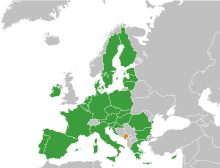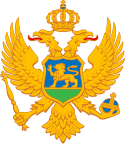
Back انضمام الجبل الأسود إلى الاتحاد الأوروبي Arabic Черногорияның Европа берлегенә инеүе Bashkir Pristupanje Crne Gore Evropskoj uniji BS Beitrittsverhandlungen Montenegros mit der Europäischen Union German Ένταξη του Μαυροβουνίου στην Ευρωπαϊκή Ένωση Greek Adhesión de Montenegro a la Unión Europea Spanish Procédure d'adhésion du Monténégro à l'Union européenne French Pristupanje Crne Gore Europskoj uniji Croatian Adesione del Montenegro all'Unione europea Italian Пристапување на Црна Гора кон Европската Унија Macedonian
| Accession of Montenegro to the European Union | |||||||||||||||||||||||||||||||||||||||||
|---|---|---|---|---|---|---|---|---|---|---|---|---|---|---|---|---|---|---|---|---|---|---|---|---|---|---|---|---|---|---|---|---|---|---|---|---|---|---|---|---|---|
 | |||||||||||||||||||||||||||||||||||||||||
| Status | Candidate negotiating (screening complete) | ||||||||||||||||||||||||||||||||||||||||
| Earliest possible entry | 2028 | ||||||||||||||||||||||||||||||||||||||||
| |||||||||||||||||||||||||||||||||||||||||
| |||||||||||||||||||||||||||||||||||||||||
| |||||||||||||||||||||||||||||||||||||||||
| |||||||||||||||||||||||||||||||||||||||||
 |
|---|
| Constitution |
Accession of Montenegro to the European Union is on the agenda for future enlargement of the EU.
Shortly after voting for independence from the State Union of Serbia and Montenegro in a referendum in 2006, Montenegro began the process of accession to the European Union by agreeing to a Stabilisation and Association Agreement with the EU, which officially came into force on 1 May 2010.
Montenegro officially applied to join the EU on 15 December 2008, and membership negotiations began on 29 June 2012. With all the negotiating chapters opened, the country enjoys widespread support among EU members' officials, and the accession of the country to the EU was considered possible by 2025 as of March 2021.[1]
It is one of nine current EU candidate countries, together with Albania, Bosnia and Herzegovina, Georgia, Moldova, North Macedonia, Serbia, Turkey, and Ukraine. Among the six candidates with open negotiations (Montenegro, Serbia, Albania, North Macedonia, Moldova and Ukraine), the most advanced stage of the negotiations - defined as meeting the interim benchmarks for negotiation chapter 23 and 24 which allow the closing process of all negotiation chapters to start - has so far only been reached by Montenegro.[2] As of June 2024, thirty out of 33 chapters remain to be closed.
The self-proclaimed target for Montenegro - shared by chief negotiator Predrag Zenović and the President of Montenegro - is to achieve membership of the EU by 2028.[3][4]
- ^ Kajosevic, Samir (26 March 2021). "Montenegro Targets 2025 to be Ready for EU Accession". Balkan Insight. Retrieved 22 May 2024.
- ^ Council of the European Union (26 June 2024). "Sixteenth meeting of the Accession Conference with Montenegro at Ministerial level (press release by the Council of the EU)". Consilium. Retrieved 1 August 2024.
- ^ "The EU-Montenegro Joint Consultative Committee: Montenegro is advancing in the EU accession path". European Economic and Social Committee. 16 April 2024. Retrieved 22 May 2024.
- ^ Tatiana Marinova; Simona-Alex Mihaleva (17 June 2024). "President Radev: Bulgaria Supports Montenegro's European Integration". BTA. Retrieved 1 August 2024.
© MMXXIII Rich X Search. We shall prevail. All rights reserved. Rich X Search